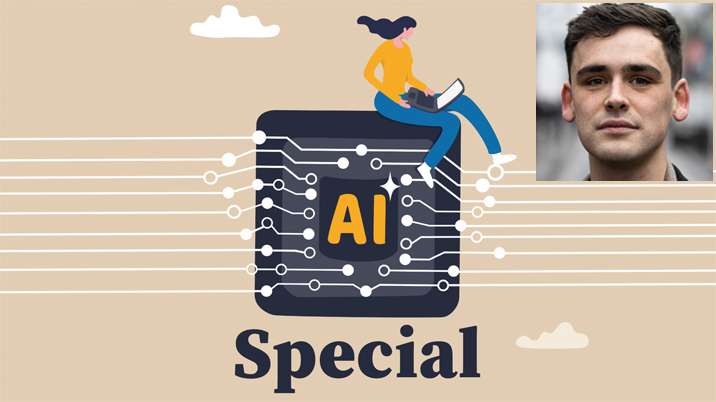
Q: How is Newsquest using AI now?
A: We are using artificial intelligence to win back time for newsrooms by introducing AI-assisted reporters, equipped with our own ‘News Creator’ tool.
The types of content they write include press-release-based content, community updates, event listings, and other similar content that, while necessary, do not require investigative skills or human insight. By completing these tasks more quickly, the AI-assisted journalists using the tool free up traditional journalists to engage more deeply with more complex, impactful stories that better utilise their skills and experience.
In practice, AI-assisted journalists provide the tool with verified information to help draft an article, with the AI working as a hyper-efficient copywriter. This process can be visualised as working with two pieces of paper: one labelled ‘notes’, where journalists place all the reliable and checked information, and another labelled ‘story’, where the AI acts as a copywriter, transforming the verified notes into a draft article. After the AI writes this draft, journalists review it to ensure it is accurate and well-written.
We’ve now published over 10,000 articles with the aid of AI, reaching millions across the UK. Highlights include major updates like the closure of the A27 on weekends for upcoming months and the installation of an £8m PET scanner at London’s Royal Free Hospital. We also deliver news on public notices, such as a licence application by Dartford Steakhouse to serve food until 3am and planning changes that transform London homes into HMOs. Our coverage extends to local events too, from weekend performances in Worcester to N-Dubz concerts in Yorkshire.
But a large part of our content comes directly from the community, featuring stories about businesses, charity events, and news about local people, like an author’s book launch or a Workington woman celebrating 40 years with M&S. These stories are what our readers expect and value on our pages and websites. With the efficiency brought by our AI-assisted reporters, we’re able to cover these stories more thoroughly and quickly.
The tool and process around it win back time to support the more substantial lead stories. This management allows traditional reporters to redirect their efforts towards investigative reporting, on-site coverage, and in-depth analysis that require a personal touch.
I always say that an AI cannot share a coffee with a councillor in the town hall chambers, nor earn the trust of a grieving mother. The quintessentially human qualities of authenticity, empathy, and connection remain the bedrock of journalism.
But what it can do is alleviate the burden of the mundane and win back time for the rest of the newsroom to capitalise on that.
Q: How do you expect your company to use AI in the future?
A: AI-assisted reporters may soon be viewed as commonplace, much like the idea of ‘internet-assisted reporters’ is today. Virtually every reporter now utilises the internet in some capacity.
We are dedicated to equipping our newsrooms with technology that not only supports their work but also enhances their capabilities. We continue to deploy AI to manage mundane tasks, freeing up time for our traditional journalists or to assist them in enhancing their reporting abilities.
In terms of handling mundane tasks, utilising AI to help create certain articles brings significant benefits for our newsrooms. We anticipate identifying further suitable tasks, other than the ones above, that AI can efficiently handle.
Regarding enhancing capabilities, a prime example is our FOI bot, which maintains a comprehensive database of all FOI email addresses and aids in drafting FOI requests to authorities. For instance, if a reporter needs to contact Brighton and Hove City Council, the bot retrieves the correct FOI email and drafts the email using the appropriate legal terminology.
Three top tips
- Avoid building soon-to-be obsolete products. AI evolves rapidly, posing the risk of developing solutions that quickly become outdated. For instance, upon its release, ChatGPT couldn’t read PDF documents or browse the web; now, it can do both. Instead of investing time, effort and money in functions that will soon be available through an API call, focus on the concept of what you’re trying to achieve.
- Don’t use AI for the sake of it. AI isn’t a catch-all solution for every problem; it’s a tool that, when implemented thoughtfully for the right tasks, can offer significant benefits. Careful deployment and clear success metrics are crucial. Avoid the misconception that AI can effortlessly resolve entrenched issues and educate yourself about the technology to ensure you have a clear rationale for its use.
- Buy-in is crucial because the success of any AI initiative hinges on acceptance. Even the best AI use case will fail if the intended users are reluctant to adopt it. It is vital to understand and communicate the benefits of the technology to this audience effectively. Without their buy-in, the technology will remain unused, and the project will ultimately fail.
Jody and the other contributors to our AI Special took part in an ‘AI Special – Q&A’ webinar on Wednesday, 26 June. You can watch the recording by registering here.
This article was included in the AI Special, published by InPublishing in June 2024. Click here to see the other articles in this special feature.












